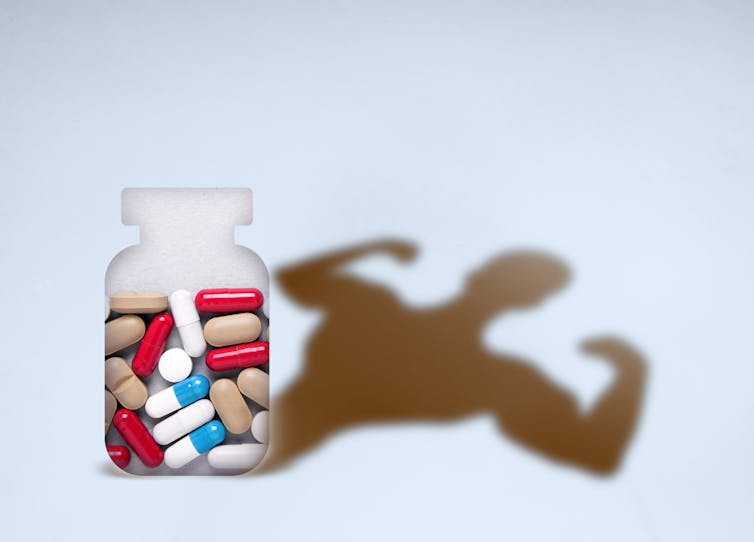
Stefan Heinze-Milne, Dalhousie University and Phillip Joy, Mount Saint Vincent University
Unapproved muscle-building drugs are being sold over the internet. These chemicals, called SARMS or selective androgen receptor modulators, are popular in part due to their perceived safety compared to anabolic steroids, but the health risks of these drugs are still widely unknown and potentially serious.
Images in society influence our body image
Images of bodies surround us in our daily life, in advertising, media, the Twitterverse and dating apps, informing the way we feel and think about our bodies. We come to understand ourselves through the images circulating in our culture and society that define what it means to belong to a particular gender.
For many men, social images create an understanding of what their bodies should look like to be considered masculine. Often the dominant ideal, both celebrated and desired, is fat-free, with bulging muscles and well-defined pecs: a celebration of strength and power.

Many men strive to embody this idealized image of masculinity, but it’s not one everyone can achieve. The difference between men’s actual bodies and the cultural ideas about masculinity that may explain the rise of muscle dysmorphia and anabolic steroid abuse.
We suggest that more discussion is needed surrounding both masculine body image ideals and the potential dangers of SARMs in our society.
Body image standards affect men differently
For many sexually diverse men (gay, bi, pansexual, queer, men who have sex with men, etc.), the consequences of not living up to idealized standards for masculine bodies can be toxic, including negative body image and body dissatisfaction.
This can influence the way people live, such as eating and exercising. For example, one study noted a small association with social media use and body dissatisfaction, eating disorder symptoms and thoughts about using anabolic steroids. Sexually diverse men have also reported engaging in intensive anaerobic training, the use of protein powders and the use of anabolic steroids to achieve their desire to become muscular.
Ethnicity can also intersect with body image for sexually diverse men. In one study, Black, East/Southeast Asian, South Asian, Latino/Brazilian gay and bisexual men report skipping meals, vomiting and taking steroids to achieve bodies that cultural messages and images define as the most masculine.
Potential danger
Anabolic steroids can be viewed by men with body dissatisfaction as a way to achieve this idolized masculine body. Now SARMs, which are not steroids per se but act in a similar way by increasing muscle mass and strength, are perceived as a safer alternative to steroids and are easily purchased online: A potential danger for those desperate to achieve these hyper-muscular bodies.

SARMS have been researched for more than 20 years as treatments for medical conditions including cancer, osteoporosis, Alzheimer’s disease and muscle-wasting, but no SARMs are approved by the FDA for any medical condition yet and they are not authorized for use in Canada. In fact, Health Canada released a public health advisory in March 2020 advocating against the use of SARMs, and reported a seizure of various SARMs from stores in Alberta.
We know little about the safety and toxicity of these drugs, which is what makes them risky. A 32-year old male recently suffered severe liver injury after taking a SARM for two weeks, suggesting there are indeed health risks.
A factor that may have contributed to this case is that recreational steroid users often take much higher doses than what is prescribed for medical patients. SARMs, like other drugs, can have dose-dependent effects. If men are taking high doses to achieve the dominant image of a masculine body, it is likely that their health risks are higher as well.
Although SARMs may end up being safe drugs when properly used for medical conditions, there are still major health concerns involved with taking SARMs currently, including liver damage, cardiovascular issues and testosterone suppression. Furthermore, the purity of SARMs bought online is currently highly questionable.
What can we do?
In light of these safety concerns, the SARMs Control Act of 2019 was introduced to the United States Congress, which seeks to tighten regulatory control over these drugs. This act effectively equates SARMs with anabolic steroids on a regulatory level. This type of regulation is necessary to help contain a drug with health risks and potential for abuse.
Thus, we have a storm brewing. On one hand we have unrealistic masculine body image standards for gay men, which promote and even demand the use of anabolic drugs to reach that goal. On the other hand, SARMs promise the idolized body and are easily available over the internet.
We need to honestly discuss the dangers of promoting unattainable masculine body image standards for men of all sexual orientations and warn about easily accessible SARMs that may not be safe to use and almost certainly not safe to abuse.
Stefan Heinze-Milne, Graduate student in Pharmacology, Dalhousie University and Phillip Joy, Assistant Professor, Mount Saint Vincent University
This article is republished from The Conversation under a Creative Commons license. Read the original article.

